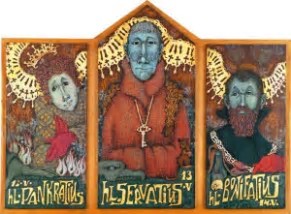The Ice Saints
A saintly collective whose festal days fall during the “blackthorn winter”.
The “Ice Saints” or “Frost Saints” is a name given to St. Mamertus, St. Pancras and St. Servatius in European folklore. They are so named because their feast days fall on the days of May 11, May 12, and May 13 respectively — a period that often brought a brief spell of colder weather in many years, including the last nightly frosts of the spring, in the Northern Hemisphere when the Julian Calendar was in effect. The introduction of the Gregorian Calendar in 1582 involved skipping 10 days in the calendar, so that the equivalent days from the climatic point of view became May 22–25. For centuries farmers and gardeners were guided in their work by this knowledge. Of them Rabelais said: “Ces saincts passent pour saincts gresleurs, geleurs, et gateurs du bourgeon.”
St. Mamertus is not counted amongst the Ice Saints in certain countries (Southern Germany, Austria, Northern Italy, Czech Republic, etc.), whereas St. Boniface of Tarsus belongs to them in other countries (Flanders, northern Italy, Czech Republic etc.) as well; St. Boniface’s feast day falling on May 14. , St. Sophia, nicknamed Cold Sophia (German kalte Sophie) on May 15 can be added in Germany, Alsace (France), Poland, etc. In Slovenia, Sophia is associated with rain and is nicknamed poscana Zofka “pissing Sophie”.
In Poland and the Czech Republic, the Ice Saints are Saints Pancras, Servatus and Boniface of Tarsus. (i.e., May 12 to May 14). To the Poles, the trio are known collectively as zimni ogrodnicy (cold gardeners), and are followed by zimna Zośka (cold Sophias) on the feast day of St.Sophia which falls on May 15. In Czech, the three saints are collectively referred to as “ledoví muži” (ice-men or icy men), and Sophia is known as “Žofie, ledová žena” (Sophia, the ice-woman).
In Sweden the German legend of the ice saints has resulted in the belief that there are special “iron nights,” especially in the middle of June, which are susceptible to frost. The term “iron nights” (järnnätter) has probably arisen through a mistranslation of German sources, where the term “Eismänner” (ice men) was read as “Eisenmänner” (iron men) and their nights then termed “iron nights,” which then became shifted from May to June.
